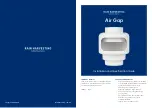
94
12.3 Interpretation of the Belin/Ambrósio Enhanced Ectasia Display
Standard elevation maps:
The left half of the Belin/Ambrósio Enhanced Ectasia Display the elevation data is shown please refer
to
Figure 113
. The first two elevation maps (placed side by side) display the baseline relative elevation
of the cornea of the best fit sph. This map is displayed for the front surface (left map) and back
surface (right map) of the cornea. The radius of curvature of the BFS in millimeters and the diameter
of the zone used to compute the BFS is noted above each map.
Exclusion elevation maps
Below the standard anterior and posterior elevation maps are the anterior and posterior exclusion
maps. These are enhanced elevation maps, which display the same elevation data as the baseline
maps, , but the method used to calculate the best fit sph (the reference surface) has been.
In these maps (both anterior and posterior) the BFS is calculated using all the raw elevation data
located outside a 4 mm circle centered on the TP of the cornea. This area of excluded data is called
the exclusion zone and the map is an exclusion map.
The location of the exclusion zone is indicated by a 4 mm red circle and cannot be modified. The
newly calculated BFS is known as the enhanced BFS. An exclusion map may be significantly different
from its corresponding baseline elevation map, or it may be very similar, depending on the relative
impact of the 4 mm exclusion zone in the original (standard) BFS computation.
Difference elevation maps
The bottom 2 maps are difference maps, i.e. they show the relative change in elevation going from
the standard (baseline) elevation map to the exclusion map. The bottom maps are based on a three-
colour scale showing the amount of elevation change that occurs when moving between the baseline
elevation map and the exclusion map:
Î
The green on the difference map represents a change in elevation (from the baseline to the
exclusion map) of less than 6 μm on the front surface and 8 μm on the back surface of the
cornea and are typically within the range seen in normal eyes.
Î
The yellow areas represent a change between 6 and 12 μm for the front surface and 8 to 20
μm for the back surface. These eyes fall in the suspicious or suspect zone.
Î
The red represents areas where the elevation difference between the 2 maps is 12 μm anteriorly
or 20 μm posteriorly and are the magnitude typically seen in eyes with known keratoconus.
In
Figure 114
, the front surface does not show much change going from the baseline to the exclusion
elevation map (the map is all green), while the posterior surface shows substantial change (red
central area).
12 Belin/Ambrósio Enhanced Ectasia Display
















































